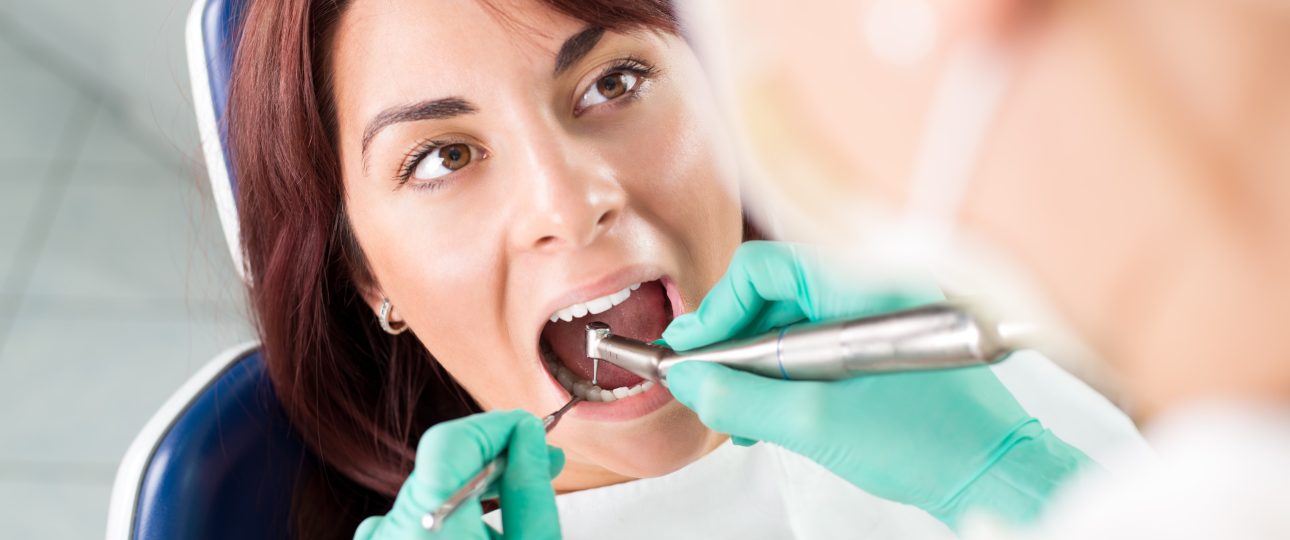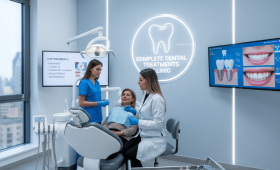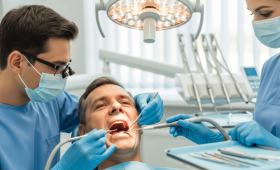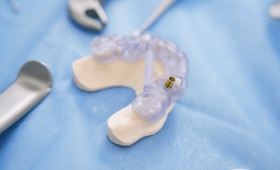All-on-4 Dental Prosthetics: Technology and Core Principle
The All-on-4 technique is an innovative dental treatment method that allows for the fixation of a full-arch prosthesis onto four specially angled implants placed in the jawbone. This technology is based on the principle of placing a total of four implants, two in the front, in the most suitable regions for implant placement. The posterior implants are placed at a 45-degree angle to benefit from the highest bone density and to avoid anatomical structures like the sinus cavities. This special design offers a fixed prosthetic solution for patients with full edentulism in a single session.
Who Are All-on-4 Dental Prosthetics Suitable For?
All-on-4 treatment is particularly for patients with full edentulism who have lost all their teeth or have teeth that need to be extracted. It is also a suitable option for patients who do not have sufficient jawbone volume for traditional implant treatment but have minimal bone loss. Additionally, individuals who are uncomfortable with their existing removable dentures and are looking for a fixed, natural-looking solution are ideal candidates for this treatment.
What is the Difference from Traditional Dentures? Why All-on-4?
Traditional dentures can move inside the mouth, causing difficulties with eating and speaking. All-on-4, being a fixed prosthesis, eliminates these problems. While traditional implant treatment typically requires 6 to 8 implants, All-on-4 uses only four. This significantly reduces treatment time and cost while also providing a less invasive procedure. The biggest advantage of All-on-4 is that a temporary prosthesis can often be attached immediately after implant placement, which reduces the patient’s toothless period to almost zero.
Stages of All-on-4 Treatment
All-on-4 treatment generally consists of several stages:
- Initial Examination and Planning: The dentist performs an intraoral examination of the patient and checks the jaw structure with panoramic X-rays or a three-dimensional dental tomography (CT). The treatment plan is determined at this stage.
- Surgical Procedure: The planned four implants are placed into the jawbone. If necessary, teeth can also be extracted in the same session.
- Temporary Prosthesis Placement: Immediately after the implants are placed, a temporary prosthesis is fixed. This prosthesis is used during the period of osseointegration (bone fusion) of the implants with the bone.
- Fabrication of the Permanent Prosthesis: Approximately 3-6 months later, the implants are expected to be fully fused with the bone. When this process is complete, the patient’s mouth measurements are taken, and the permanent, durable prosthesis is produced and fixed to the implants.
All-on-4 Dental Surgery Process
The surgery is usually performed under local anesthesia and takes about 2-3 hours for a single arch. During the surgical procedure, the dentist places four specially angled implants into the jawbone. If needed, existing teeth can be extracted in the same session. When the operation is complete, the patient typically receives their temporary teeth on the same day and can return to their social life.
Materials Used for All-on-4 Dental Prosthetics
Implants are generally made of titanium. Titanium is preferred because it is biologically compatible with the human body and fuses easily with bone. The prosthetics, on the other hand, can be made from various materials. While temporary prostheses are usually made of acrylic, more durable and aesthetic materials like zirconia, metal-supported porcelain, or acrylic are used for permanent prostheses. Zirconia is often preferred, especially for its natural appearance and high durability.
Advantages of All-on-4 Dental Prosthetics Treatment
- Quick Solution: It generally offers a permanent solution to the problem of full edentulism in a single surgical operation.
- Immediate Function: Thanks to the placement of temporary teeth on the day of treatment, patients immediately regain their ability to eat and speak.
- High Success Rate: It is a clinically proven method that has been applied for many years.
- Less Bone Requirement: Thanks to specially angled implants, it can be applied even in patients with bone loss, and there is often no need for additional bone grafting.
- Natural Look and Feel: Being a fixed prosthesis, it offers a more natural feel and an aesthetic smile compared to traditional dentures.
- Comfort and Confidence: Since it is fixed, it does not move, slip, or fall out, which increases social confidence.
Disadvantages and Risks of All-on-4 Dental Prosthetics Treatment
Like any surgical procedure, All-on-4 treatment has some risks. These can include infection, failure of the implant to fuse with the bone, nerve damage, and temporary swelling. These risks can be minimized by having the treatment performed by an experienced dentist. A disadvantage is that in the event of implant failure, the treatment may need to be repeated. Additionally, repairing damage to the permanent prosthesis can be more difficult than with traditional dentures.
All-on-4 Dental Prosthetics Recovery Process and Care
Mild swelling and pain are normal in the first few days after surgery. During this period, it is important to regularly use the painkillers and antibiotics recommended by your dentist. With the temporary prosthesis, you should eat soft foods and avoid excessive pressure on the implants. After the permanent prosthesis is placed, attention should be paid to oral hygiene by using regular tooth brushing, dental floss, and interdental brushes, as well as special cleaning tools.
All-on-4 Dental Prosthetics Treatment Cost
The treatment cost varies depending on the patient’s overall oral health, the type of material used (zirconia, porcelain, etc.), the need for additional treatments, and the geographical location of the clinic. Before starting the treatment, you should definitely consult a dentist to get detailed planning and pricing information.
How Permanent Are All-on-4 Dental Prosthetics?
All-on-4 prostheses can be used for a lifetime with proper oral hygiene and regular dentist check-ups. Studies show that the ten-year success rate of the implants is over 98%. The prosthesis itself can be renewed at certain intervals depending on the material used.
All-on-4 and Tooth Extraction: Is It Possible on the Same Day?
Yes, this is one of the biggest advantages of the All-on-4 technique. If the patient’s jaw structure is suitable, the remaining teeth can be extracted in the same session, and then the implants can be placed immediately, followed by the placement of the temporary prosthesis. This eliminates the patient’s toothless period.
Solution for Full Edentulism: Lower and Upper Jaw Applications
The All-on-4 technique is suitable for patients with full edentulism in both the lower and upper jaw. It can even be applied to both arches simultaneously. The aim of the technique is to provide a fast, comfortable, and aesthetic solution for patients experiencing full edentulism.
Goodbye to Denture Use: Comfort and Confidence
All-on-4 eliminates the discomfort and insecurity caused by traditional removable dentures. Since it is fixed, you do not have to worry about the prosthesis moving or falling out during daily activities such as eating, speaking, and smiling. This significantly improves the quality of life for patients.
Aesthetics and Naturalness: Impact on Smile Design
All-on-4 prostheses are specially designed according to the person’s facial features and aesthetic expectations. These prostheses provide an aesthetic and natural appearance to the patient’s smile by mimicking the natural gum and tooth junction.
Does It Prevent Jawbone Loss?: Bone Integrity
All-on-4 implants transmit chewing forces directly to the jawbone, helping the bone to stay alive and preventing its resorption. This way, bone integrity is preserved by preventing future bone loss. Traditional dentures, on the other hand, cannot prevent bone loss.
Care and Cleaning Routine: Protecting Your All-on-4
The care of All-on-4 prostheses should be done like natural teeth, with regular brushing, flossing, and interdental brushes. Cleaning the areas around the prosthesis and implants is vital to reduce the risk of infection and peri-implantitis (inflammation around the implant).
Misconceptions: Myths About All-on-4
- MYTH: “All-on-4 is expensive and not affordable for everyone’s budget.” REALITY: It can be more cost-effective than traditional implant treatment, and the comfort and permanence it provides in the long run justify its cost.
- MYTH: “The treatment is very painful, and the recovery process is difficult.” REALITY: Since the treatment is performed under local anesthesia, no pain is felt, and the recovery process is generally more comfortable than expected.
Pre-Treatment Preparations: What Needs to Be Done
Before starting the treatment, you should have a detailed consultation with your dentist and mention any existing health problems and medications you use. Quitting smoking and paying attention to oral hygiene will also increase the success of the treatment.
Choosing a Specialist: The Right Doctor for a Successful Treatment
All-on-4 treatment is a procedure that requires special surgical knowledge and experience. For a successful outcome, it is extremely important to choose an experienced and specialized dentist in this field. Examining the cases the doctor has done before and checking their references will help you make the right choice.



